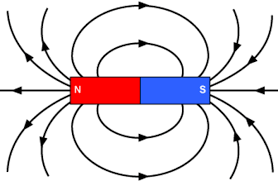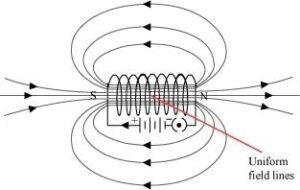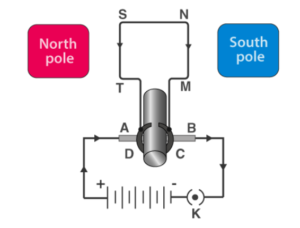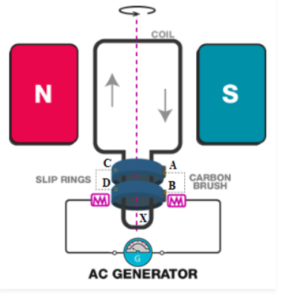NCERT Solutions Class 10 Science
The NCERT Solutions in English Language for Class 10 Science Chapter – 13 (Magnetic Effects of Electric Current) has been provided here to help the students in solving the questions from this exercise.
Chapter – 13 (Magnetic Effects of Electric Current)
Questions
1. Why does a compass needle get deflected when brought near a bar magnet ?
Answer – Compass needle is a small magnet which experiences a force in the magnetic field of a bar magnet. Due to this force, it gets deflected.
Questions
1. Draw magnetic field lines around a bar magnet.
Answer – Magnetic field lines of a bar magnet emerge from the North Pole and terminate at the South Pole, as shown in the figure below.

2. List the properties of magnetic field lines.
Answer – The properties of magnetic lines of force are as follows.
- Magnetic field lines emerge from the north pole.
- They merge at the south pole.
- The direction of field lines inside the magnet is from the south pole to the north pole.
- Magnetic lines do not intersect with each other.
3. Why do not two magnetic field lines intersect each other ?
Answer – If two field lines of a magnet intersect, then at the point of intersection, the compass needle points in two different directions. This is not possible. Hence, two field lines do not intersect each other.
Questions
1. Consider a circular loop of wire lying in the plane of the table. Let the current pass through the loop clockwise. Apply the right hand rule to find out the direction of magnetic field inside and outside the loop.
Answer – Magnetic field inside the loop is perpendicular to the plane of table and in the downward direction. However, outside the loop, magnetic field is perpendicular to the plane of the table and in the upward direction.
2. The magnetic field in a given region is uniform. Draw a diagram to represent it.
Answer – The uniform magnetic field is represented by parallel equispaced lines of equal length as follows:

3. Choose the correct option :
The magnetic field inside a long straight solenoid carrying current is :
(a) zero
(b) decreases as we move towards its ends .
(c) increases as we move towards its ends
(d) is the same at all points.
Answer – (d) is the same at all points.
Questions
1. Which of the property a proton can change when it moves freely in a magnetic field ? (There may be more than one correct answer).
(a) mass
(b) speed
(c) velocity
(d) momentum.
Answer – (c) Velocity and (d) momentum
2. In activity 13.7, how do we think the displacement of rod AB will be affected if (i) current is rod AB is increased, (ii) a stronger horse shoe magnet is used, and (iii) length of the rod AB is increased?
Answer – A current-carrying conductor placed in a magnetic field experiences a force. The magnitude of force increases with the amount of current, strength of the magnetic field, and the length of the conductor. Hence, the magnetic force exerted on rod AB and its deflection will increase if
(i) current in rod AB is increased
(ii) a stronger horseshoe magnet is used
(iii) length of rod AB is increased
3. A positively charged partical (alpha partical) projected towards west is deflected towards north by a magnetic field. The direction of magnetic field is
(a) towards south
(b) towards east
(c) downward
(d) upward.
Answer – (d) upward
Questions
1. State Fleming’s left hand rule with a labelled diagram.
Answer – Fleming’s left hand rule states that if we arrange the thumb, the centre finger, and the forefinger of the left hand at right angles to each other, then the thumb points towards the direction of the magnetic force, the centre finger gives the direction of current, and the forefinger points in the direction of magnetic field.
2. What is the principle of electric motor ?
Answer – Electric motor works on the principle that a current carrying conductor placed perpendicular to a magnetic field experiences a force.
3. What is the role of the split ring in an electric motor ?
Answer – The split-ring in an electric motor reverses the direction of current in the armature coil of the motor. Therefore, the direction of the force acting on the two arms of the coil is also reversed. As a result of this, the coil of d.c. motor continues to rotate in the same direction.
Questions
1. Explain different ways to induce current in a coil.
Answer – Different ways to induce current in a coil are as follows:
- If a magnetic field is changed around a coil then an induced current is set up in the coil.
- If a coil is moved in magnetic field, then again an induced current is set up in the coil.
- If a coil is rotated in a uniform magnetic field.
Questions
1. State the principle of electric generator.
Answer – It is based on the principle of electromagnetic induction. That is, the changing magnetic field induces current in the coil.
2. Name some sources of direct current.
Answer – A dry cell, a battery, a solar cell, d.c. generator etc. are some sources of direct current.
3. Which source produces alternating current ?
Answer – AC generator (which converts mechanical energy into alternating current or electricity) and an oscillator (a device which converts D.C. into A.C.) are the sources which produce alternating current.
4. Choose the correct option :
A rectangular coil of copper wires is rotated in a magnetic field. The direction of the induced current changes once in each
(a) two revolutions
(b) one revolution
(c) half revolution
(d) one-fourth revolution,
Answer – (c) half revolution
Questions
1. Name two safety measures commonly used in electric circuit and appliances.
Answer – The two safety measures are:
Fuse – A fuse should be connected to each circuit because it prevents excessive current from flowing through the circuit. When the current in the circuit exceeds the fuse element’s maximum limit, the fuse melts, interrupting the current flow and protecting the appliance connected to the circuit.
Earthing – The user is protected from electric shocks via earthing. Any current leakage in an appliance is transmitted to the ground through earthing, preventing electrocution of those using the item.
2. An electric oven of 2 kW power rating is operated in a domestic electric circuit (220 V) that has a current rating of 5 A. What result do you expect ? Explain.
Answer –
Power rating of electric oven (P) = 2 kW = 2000 W
Current drawn (I) = P/V = 2000/220 = 9.09 A.
As the current rating of domestic electric circuit is only 5A the oven draws a current of 9.09 A. Which is more than the current rating; hence the circuit will be damaged due to overheating / overloading.
3. What precautions should be taken to avoid the overloading of domestic electric circuit ?
Answer – The precautions that should be taken to avoid the overloading of domestic circuits are as follows:
- Too many appliances should not be connected to a single socket.
- Too many appliances should not be used at the same time.
- Faulty appliances should not be connected in the circuit.
- Fuse should be connected in the circuit.
Exercises
1. Which of the following correctly describes the magnetic field near a long straight wire ?
(a) the field consists of straight lines perpendicular to the wire
(b) the field consists of straight lines parallel to the wire
(c) the field consists of radial lines originating from the wire
(d) the field consists of concentric circles centered on the wire.
Answer – (d) The field consists of concentric circles centred on the wire.
2. The phenomena of electromagnetic induction is
(a) the process of charging a body
(b) the process of generating magnetic field due to current passing through a coil
(c) producing induced current in a coil due to relative motion between a magnet and the coil
(d) the process of rotating a coil of an electric motor.
Answer – (c) producing induced current in a coil due to relative motion between a magnet and the coil
3. The device used for producing electric current is called a
(a) generator
(b) galvanometer
(c) ammeter
(d) motor.
Answer – (a) generator
4. The essential difference between an AC generator and a DC generator is that
(a) AC generator has an electromagnet while a DC generator has permanent magnet
(b) DC generator will generate a higher voltage
(c) AC generator will generate & higher voltage
(d) AC generator has slip rings while the DC generator has a commutator.
Answer – (d) AC generator has slip rings while the DC generator has a commutator.
5. At the time of short circuit, the current in the ciruit
(a) reduces substantially
(b) does not change
(c) increases heavily
(d) vary continuously.
Answer – (c) increases heavily
6. State whether the following statements are true or false :
(a) an electric motor converts mechanical energy into electrical energy.
(b) an electric generator works on the principle of electromagnetic induction
(c) the field at the centre of a long circular coil carrying current will be parallel straight lines
(d) a wire with a green insulation is usually the live wire.
Answer –
(a) an electric motor converts mechanical energy into electrical energy. (False)
(b) an electric generator works on the principle of electromagnetic induction. (True)
(c) the field at the centre of a long circular coil carrying current will be parallel straight lines. (True)
(d) a wire with a green insulation is usually the live wire. (False)
7. List three sources of magnetic fields.
Answer – Three methods of producing magnetic fields are as follows:
- a permanent magnet
- a current carrying conductor
- a current carrying solenoid.
8. How does a solenoid behave like a magnet ? Can you determine the north and south poles of a current carrying solenoid with the help of a bar magnet. Explain.
Answer – When current is passed through a solenoid coil, magnetic field is produced due to presence of turns in same direction. As a result, the resultant magnetic field is very strong and uniform. Solenoid behaves like a strong bar magnet. We can determine the poles of magnet formed by solenoid. The end of solenoid connectd with positive terminal behaves like South Pole and the end connected with negative terminal behaves as North Pole.
9. When is the force experienced by a current carrying conductor placed in magnetic field is the largest ?
Answer – The force experienced by a current carrying conductor placed in a magnetic field is largest when the conductor is placed with its length in a direction perpendicular to that of magnetic field.
10. Imagine that you are sitting in chamber with your back to one wall. An electron beam, moving horizontally from back wall towards the front wall, is deflected by a strong magnetic field to your right side. What is the direction of magnetic field?
Answer – An electron beam moving horizontally from back wall towards the front wall is equivalent to a current flowing in the opposite direction. The deflection of electron beam as seen by the observer is to his right side. On applying Fleming’s left-hand rule we find that the magnetic field is acting in vertically downward direction.
11. Draw a labelled diagram of an electric motor. Explain its principle and working. What is the function of a split ring in an electric motor ?
Answer – Electric motor labelled diagram of an electric motor is as follows:
Principle : Electric Motor is based on the fact that a current carrying conductor placed perpendicular to the magnetic field experiences a force.

A device that transforms electrical energy into mechanical energy is known as an electric motor. It operates on the principle of the current magnetic effect. A simple electric motor is seen in the diagram below.
When the switch is closed and electricity is allowed to flow through the coil MNST, the coil begins to revolve in an anticlockwise direction. This is due to a downward force operating on the length MN and an upward force acting on the length ST at the same time. As a result, the coil rotates in the opposite direction as the clock. The magnetic fields act from left to right normal to the length MN, and current flows from M to N. A downward force acts along the length MN, according to Fleming’s Left Hand rule. The current travels from S to T along the length ST, and the magnetic field operates from left to right. As a result, along the length ST, an upward force acts. The coil rotates anti-clockwise due to the combined effects of these two forces. The positions of MN and ST swap every half a rotation. Brush B comes into touch with half ring C, and rush C comes into contact with half ring D. As a result, the current in the coil MNST is reversed.
12. Name some devices in which electric motors are used.
Answer – Electric cars, rolling mills, electric fans, hair dryers, mixers, blenders etc.
13. A coil of insulated copper wire is connected to a galvanometer. What will happen if a bar magnet is (i) pushed into the coil. (ii) withdrawn from inside the coil (iii) held stationary inside the coil?
Answer – A current induces in a solenoid if a bar magnet is moved relative to it. This is the principle of electromagnetic induction.
(i) When a bar magnet is pushed into a coil of insulated copper wire, a current is induced momentarily in the coil. As a result, the needle of the galvanometer deflects momentarily in a particular direction.
(ii) When the bar magnet is withdrawn from inside the coil of the insulated copper wire, a current is again induced momentarily in the coil in the opposite direction. As a result, the needle of the galvanometer deflects momentarily in the opposite direction.
(iii) When a bar magnet is held stationary inside the coil, no current will be induced in the coil. Hence, galvanometer will show no deflection.
14. Two circular coils A and B are placed close to each other. If the current in the coil A is changed, will some current be induced in the coil B 1 Give reason.
Answer – When current in coil A is changed, a changing magnetic field is set up around it. This changing magnetic field also links with coil B and hence some current will be induced in coil B due to electromagnetic induction.
15. State the rule to determine the direction of a
(i) magnetic field produced around a straight conductor-carrying current,
(ii) force experienced by a current-carrying straight conductor placed in a magnetic field which is perpendicular to it, and
(iii) current induced in a coil due to its rotation in a magnetic field.
Answer –
(i) To know the direction of magnetic field produced around a straight conductor we make use “Right hand thumb Rule”.
(ii) To find the direction of force experienced by a current carrying straight conductor placed in a magnetic field we make use “Fleming’s left hand rule”.
(iii) For finding the direction of current induced in a coil we use “Fleming’s right hand rule”.
16. Explain the underlying principle and working of an electric generator by drawing a labelled diagram. What is the function of brushes ?
Answer –
Principle : It worked on the principle of Electromagnetic Induction. When amount of flux linked with the coil changes, an e.m.f. is induced in the coil.

Working : As the armature coil is rotated in the magnetic field, angle between the field and normal to the coil changes continuously. Therefore, the magnetic flux linked with the coil changes. An e.m.f. is induced in the coil.
The function of Brushes : The purpose of brushes is to pass on current from the armature coil to the external load resistance.
17. When does an electric short circuit occur ?
Answer – When live wire and neutral wire touch each other (i.e. come in direct contact.), the resistance of the circuit becomes small and hence large amount of current flows through it. As a result, large amount of heat is produced and the circuit catches fire.
18. What is the function of an earth wire ? Why is it necessary to earth metallic casings of electric appliances ?
Answer – The metallic body of electric appliances is connected to the earth by means of earth wire so that any leakage of electric current is transferred to the ground. This prevents any electric shock to the user. That is why earthing of the electrical appliances is necessary.

Leave a Reply